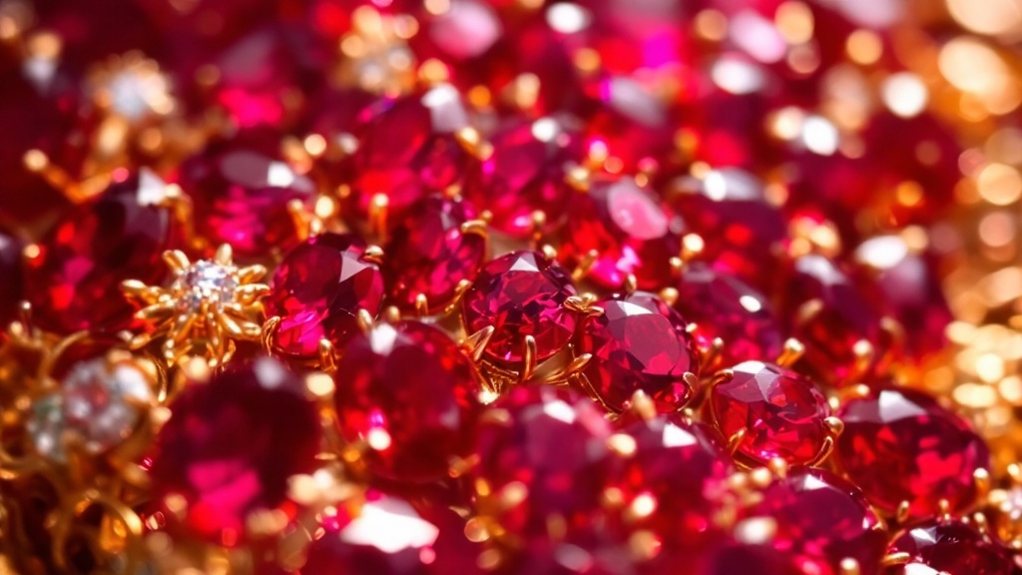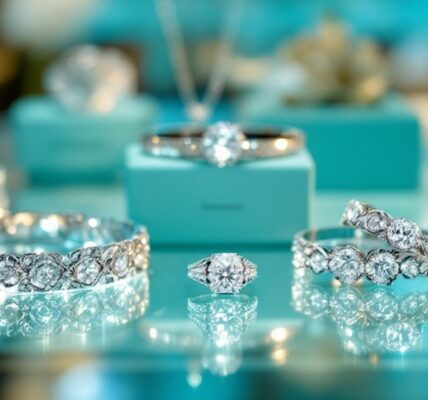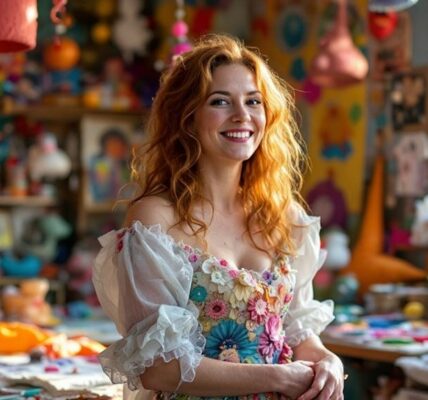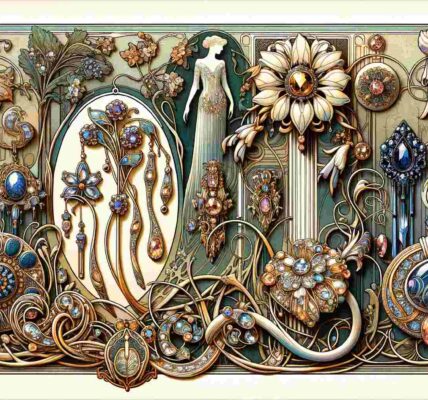Iconic Jewellery Houses and Their Designers: Van Cleef & Arpels – Masters of the Mystery Setting
Article Contents
Van Cleef & Arpels: Masters of the Mystery Setting
Van Cleef & Arpels holds a prestigious position in the realm of high jewellery, consistently raising the bar with its innovative designs and exceptional craftsmanship. At the heart of its esteemed reputation lies the Mystery Setting, a technique that transforms the traditional gemstone arrangement by giving the illusion of stones floating seamlessly, devoid of any visible prongs or metal. Introduced in the early 20th century, this distinct method not only set the house apart but also established a new benchmark in jewellery artistry.
Challenges and Influence on Modern Design
The intricacy of the Mystery Setting presents significant challenges for contemporary designers. It demands precision and skill, as each stone must be cut and set with meticulous accuracy to achieve the signature seamless appearance. This level of craftsmanship requires a deep understanding of materials and techniques, which can be daunting given the complexity involved.
Despite these challenges, the Mystery Setting continues to inspire modern trends in luxury jewellery. Its influence is seen in the pursuit of creating pieces that appear effortless yet are technically complex. The demand for such artistry has led to a renewed interest in mastering traditional techniques, ensuring that the legacy of Van Cleef & Arpels continues to inspire future generations. As artisans and designers seek to emulate the enigmatic allure of the Mystery Setting, they are also unraveling antique jewelry mysteries to uncover forgotten techniques and designs. This dedication to both innovation and tradition ensures that the legacy of the Mystery Setting will continue to captivate and influence the world of luxury jewelry for years to come. The ongoing pursuit of perfecting this technique exemplifies the timelessness and enduring appeal of Van Cleef & Arpels’ creations.
In the words of a leading jewellery designer, "The Mystery Setting is more than a technique; it's a testament to the harmony between innovation and tradition, reminding us of the beauty that lies in meticulous craftsmanship."
This enduring technique not only honours the heritage of Van Cleef & Arpels but also keeps pushing the boundaries of what is possible in jewellery design, ensuring its relevance in the ever-evolving world of haute joaillerie.
Main Highlights
Van Cleef & Arpels: Masters of the Mystery Setting
Van Cleef & Arpels introduced the Mystery Setting in 1933, a groundbreaking technique that creates the illusion of floating gemstones, completely concealing any supporting prongs. This innovation revolutionised the jewellery world by offering a seamless and elegant appearance.
Crafting a piece using this method is no small feat; it demands over 300 hours of dedicated work from highly skilled artisans who have honed the necessary expertise. Only a select few have mastered this intricate process, which speaks volumes about the artistry involved.
Over time, the Mystery Setting has evolved, incorporating novel designs such as the *Vitrail Mystery Set*. This particular design features coloured sapphires that give off a stunning transparent effect, further showcasing the brand's creativity and continual innovation.
The technique captures the avant-garde spirit of the 1930s, embodying Van Cleef & Arpels' commitment to exceptional design. Their creations, like the renowned *Peony brooch*, not only reflect timeless style but also attract admiration from royalty and celebrities alike. These pieces stand as testaments to the brand's enduring allure and excellence.
As one of the brand's artisans once remarked, "Creating beauty is a journey, not a destination." This sentiment perfectly encapsulates the dedication and passion that Van Cleef & Arpels invest in each of their masterpieces.
Founding and Early Years
The Beginnings of Van Cleef & Arpels
In the late 19th century, the combination of family connections and entrepreneurial spirit led to the creation of Van Cleef & Arpels, now a renowned name in luxury jewellery. The marriage of Estelle Arpels and Alfred Van Cleef in 1895 marked the start of an enduring legacy.
A year later, Alfred and his father-in-law, Salomon Arpels, established the foundation for what would grow into a globally recognised jewellery brand. The business was truly a family affair, with Estelle's brothers—Charles, Julien, and Louis Arpels—joining in the following years, each playing a part in enhancing the Maison's reputation. Renée Puissant, Alfred and Estelle's daughter, later joined the firm as Artistic Director, further solidifying the family's influence on the brand's creative direction.
Strategic Expansion and Innovation
Early growth for Van Cleef & Arpels was both daring and deliberate. In 1906, they opened their first boutique at 22 Place Vendôme, which would become synonymous with the brand's elegance. The company was the first French jewellers to expand into Japan and China, illustrating their pioneering spirit in reaching international markets.
This was just the start of their outreach to affluent holiday destinations like Deauville and Monte-Carlo, illustrating their dedication to attracting discerning clients. Their innovative designs, known for asymmetry and fluid movement, captured the attention of the early 20th-century luxury market.
By 1925, their creations had received significant accolades, cementing their status in the world of fine jewellery.
"Jewellery is not just an adornment; it is a reflection of one's inner beauty and personal history."
Invention of the Mystery Setting
The Art of the Mystery Setting
In late 1933, the esteemed jeweller Van Cleef & Arpels obtained a patent for their innovative Mystery Setting, or *Serti Mystérieux*, marking a significant advancement in the world of gem setting.
This ingenious method uses nearly invisible gold or platinum channels to secure each precisely cut stone, giving the appearance of gems that seem to float effortlessly. This approach elevated traditional jewellery design into a seamless and otherworldly form of artistic expression. The technique was first showcased to the world at the 1937 International Exhibition of Art and Technology in Modern Life in Paris, where it received widespread acclaim. Van Cleef & Arpels has continued to evolve this cornerstone technique, adapting it to embrace various trends and styles over the decades.
Initially applied to flat surfaces, the Mystery Setting was adapted over time to fit more intricate shapes and designs. This adaptation solidified its place as a signature of Van Cleef & Arpels' remarkable craftsmanship and an important milestone in the evolution of jewellery design.
An employee at Van Cleef & Arpels once remarked, "The Mystery Setting is not just a technique; it's an art form that embodies the magic of jewellery." Such sentiments capture the essence of this unique setting, which continues to inspire awe and admiration among jewellery enthusiasts and collectors alike.
Patented Innovation in 1933
Van Cleef & Arpels' Mystery Setting: A Jewel of Innovation from 1933
The Mystery Setting by Van Cleef & Arpels stands as a pivotal development in jewellery design. During the dynamic 1930s in Paris, a hotbed for artistic and cultural creativity, Van Cleef & Arpels distinguished themselves with their patented technique—French Patent No. 764,966, granted on 2 December 1933. While not the original invisible setting, this patent represented a refined version, advancing beyond earlier patents by Chaumet in 1904 and Cartier in 1933, which had not seen widespread application. The Van Cleef & Arpels method became an iconic signature, transforming jewellery aesthetics by removing visible metal prongs, thus creating smooth expanses of colour. This technique required immense precision, as the gemstones had to be perfectly colour-matched and meticulously cut to fit together seamlessly. The Zip necklace, a later innovation by Van Cleef & Arpels, similarly showcases their technical mastery, allowing the piece to function as both a necklace and a bracelet.
More than just a shift in appearance, this innovation paved the way for designing intricate three-dimensional jewellery pieces. The method involved crafting a precious-metal mesh with rails to securely hold the gems. Charles-Salomon Arpels further improved this technique by patenting its use on curved surfaces in 1938, resulting in complex and sculptural designs. The Mystery Setting embodies the spirit of design freedom, offering an elegant blend of sophistication and creativity that continues to attract jewellery enthusiasts globally.
As Jacques Arpels famously said, "To be lucky, you must believe in luck," which could be seen as an apt description of how the Mystery Setting captures the essence of beauty and precision in jewellery artistry.
Gem Setting Technique
The Art of Gem Setting: Van Cleef & Arpels' Mystery Setting****
Crafting the esteemed Mystery Setting at Van Cleef & Arpels exemplifies a highly intricate gem-setting technique that highlights the brand's unwavering dedication to precision and artistry.
This method, representing the pinnacle of gem accuracy and setting complexity, begins with the meticulous selection of gems based on their colour, clarity, and pavilion thickness. Each stone is expertly shaped into squares to minimise material waste, ensuring that only the finest quality stones embellish the jewellery.
This delicate process requires a harmonious collaboration between goldsmiths and gem-cutters, who skilfully transform raw gems into works of art. The partnership between Van Cleef & Arpels and the Langlois workshop was instrumental in developing the Mystery Setting technique, resulting in innovative pieces that continue to captivate. Inspired by the know-how of micro-mosaics, this signature technique has become a hallmark of Van Cleef & Arpels' craftsmanship.
The technical execution of the Mystery Setting is remarkable. Gems are mounted onto an intricate rail system that is nearly invisible, allowing them to appear as if they are seamlessly floating across the piece.
These rails, thinner than 0.2mm, support the gems while maintaining the illusion of a continuous surface. Near the culet, grooves are used for precise alignment, ensuring a flawless appearance.
This complex latticework requires at least 300 hours of meticulous labour, showcasing the brand's commitment to craftsmanship.
Since its creation, the Mystery Setting has evolved beyond its initial flat surface constraints to incorporate three-dimensional forms, continuing to inspire with its innovation and elegance.
*"In every stone, there's a story of art and precision," says a master craftsman at Van Cleef & Arpels.*
Artistic Design Revolution
Artistic Ingenuity in Jewellery Design
Van Cleef & Arpels' unwavering commitment to exquisite craftsmanship reached its pinnacle with the creation of the Mystery Setting in 1930s Paris—a decade characterised by vibrant cultural expression. The patent, filed in December 1933, emerged at a time when artistic creativity was flourishing, reflecting the era's innovative spirit. Their innovative technique, requiring extensive labour, often demanded no fewer than 300 hours to produce a single piece, showcasing the meticulous dedication involved in crafting these masterpieces.
This technique revolutionised jewellery design by concealing visible prongs, achieving a seamless aesthetic that epitomised the avant-garde ethos of the period. The Mystery Setting technique became a pillar of Van Cleef & Arpels in the 1950s, underscoring its enduring significance and the firm's dedication to pushing the boundaries of design innovation.
This innovative method, involving a precious-metal mesh with rails, allowed for the insertion of notched stones to produce the illusion of floating gems. Such a technique enabled the crafting of jewellery with intricate, three-dimensional motifs, breaking away from traditional design constraints.
Over time, this approach evolved to incorporate complex volumes and hexagonal stones, resulting in floral pieces, cocktail jewellery, and architectural forms that continue to captivate the imagination.
The Mystery Setting became a hallmark for Van Cleef & Arpels, featured in iconic creations like the Peony brooch. This pioneering approach not only represents a significant historical advancement in jewellery craftsmanship but also serves as a continual source of inspiration, celebrating the essence of cultural and artistic freedom.
"Art is not freedom from discipline, but disciplined freedom." – John F. Kennedy
Evolution Through the Decades
Van Cleef & Arpels: A Journey Through Time
Van Cleef & Arpels has consistently redefined jewellery design over the years, marked by its inventive approach and stylistic progression. In the 1920s and 1930s, the brand embraced the geometric charm of Art Deco.
This era witnessed the introduction of the Mystery Setting technique, which was patented in 1933, not 1926. Early pieces, exhibiting minimalist elegance in materials like platinum and diamonds, primarily took the form of brooches and pendants, setting the stage for more colourful creations.
The 1940s and 1950s brought a burst of creativity in the post-war era, with the Alhambra collection not yet gaining popularity, as it was introduced later. The Mystery Setting evolved to include complex floral and animal motifs, featuring vibrant gemstones like turquoise and onyx, and leading to the creation of the iconic ballerina brooches.
The 1960s and 1970s saw the influence of psychedelic art, integrating opals and iridescent stones into abstract and dynamic designs, such as the elegant beaded Perlée collection.
Moving into the 1980s and beyond, the Alhambra collection, which was introduced in 1968, experienced a resurgence through modern reinterpretations. The technique advanced with the inclusion of sapphires and rubies, while the High Jewellery collection represented the peak of intricate design.
Collaborations in the 2000s propelled these innovations, cementing the brand's legacy in artistic freedom.
"Van Cleef & Arpels isn't just about jewellery," says a renowned designer, "it's about crafting history with each piece."
Mastery and Recognition
Mastery and Recognition of Van Cleef & Arpels
The exceptional craftsmanship of Van Cleef & Arpels, particularly exemplified by their Mystery Setting, has elevated the brand's jewellery to high-status levels. This intricate technique is a testament to the jeweller's skill, often leading their creations to feature prominently at prestigious auction houses and achieve remarkable success. The Mystery Setting, first patented in 1933 as a "method for setting precious stones", showcases the brand's innovative spirit and technical excellence. The complexity and artistry involved in this method have earned the brand recognition at elite exhibitions, underscoring its significant place in the high jewellery sector. In 2017, Van Cleef & Arpels' commitment to exceptional craftsmanship was further highlighted through its collaboration with Master Moriguchi, which showcased the convergence of Eastern and Western cultures.
Through painstaking attention to detail and technical skill, Van Cleef & Arpels consistently attracts collectors and enthusiasts, reinforcing its reputation as an emblem of elegance and ingenuity.
As one expert jeweller put it, "Van Cleef & Arpels has transformed jewellery-making into an art form, where each piece tells a unique story of beauty and precision."
Complexity and Craftsmanship
Intricate Craftsmanship and Van Cleef & Arpels' Mystery Setting
Van Cleef & Arpels have long been celebrated for their innovative approach to high jewellery, with the Mystery Setting being a prime example of their dedication to complexity and craftsmanship. Introduced in 1933, this patented technique highlights the Maison's commitment to meticulous artistry and precision.
What makes this setting unique is the method of embedding precious stones into specially crafted gold rails, creating a flawless, velvet-like surface that enhances the stones' natural allure. This method not only maintains the gemstones' intrinsic beauty but also opens up new avenues for creative expression with styles like the Individual, Hexagonal, and Navette Mystery Sets, each offering unique volumes and forms. Additionally, the selection of materials is meticulous, with expert gemologists choosing each stone to ensure only the finest are used in the creations. The Mystery Setting is a hallmark of Van Cleef & Arpels that has been admired by royalty and celebrities, such as Queen Sofia of Spain and Grace Kelly, further cementing the Maison's reputation for timeless elegance.
The intricate nature of the Mystery Setting requires a profound level of expertise, with only a handful of artisans possessing the skills to master its intricacies. Crafting a single clip can demand as much as 300 hours of focused labour, a testament to the time-intensive process that Van Cleef & Arpels has honed over the years.
This extraordinary quality is further demonstrated in their groundbreaking collections, such as the Legend of Diamonds – 25 Mystery Set Jewels High Jewellery series. The Mystery Setting continues to be a hallmark of Van Cleef & Arpels' dedication to craftsmanship and artistic innovation.
As Victor Hugo once said, "Art is a collaboration between God and the artist, and the less the artist does the better." This quote beautifully resonates with Van Cleef & Arpels' philosophy, where the natural beauty of stones is enhanced through exquisite craftsmanship, allowing the artistry to speak for itself.
Auction House Achievements
Van Cleef & Arpels is celebrated not just for its meticulous craftsmanship but also for the extraordinary successes of its pieces at auction houses around the world. The notable "Mystery Set" brooch fetched an impressive £850,000 at Christie's in 2019, underscoring the brand's enduring appeal.
In 2018, Sotheby's saw the sale of a stunning "Emerald and Diamond Necklace" for £2.2 million, while a "Sapphire and Diamond Ring" achieved £1.1 million at Christie's in the previous year. These sales highlight the lasting value and desirability of Van Cleef & Arpels' creations.
The market consistently shows strong demand for their jewellery, often exceeding auction estimates. This trend is fuelled by a deep appreciation for rare and distinctive pieces, which command high prices.
The brand's rigorous authentication process, ensuring each piece's history and worth, further enhances buyer confidence. Notable collections from figures like the Duchess of Windsor and Elizabeth Taylor have featured prominently at auctions, showcasing the timeless allure and historical importance of their jewellery.
This combination of artistry and authenticity secures Van Cleef & Arpels' position as a symbol of luxury and excellence.
"Van Cleef & Arpels embodies timeless elegance that transcends generations," noted a prominent jewellery historian.
Prestigious Exhibition Features
Celebrating Van Cleef & Arpels: A Fusion of Art and Heritage
Exhibitions often pay homage to the artistic prowess and global acclaim of Van Cleef & Arpels, offering an insightful glimpse into the brand's rich history and cutting-edge designs.
One such exhibition, *Mastery of an Art: Van Cleef & Arpels – High Jewellery and Japanese Crafts,* held at The National Museum of Modern Art, Kyoto, beautifully demonstrated this concept. This event highlighted the intricate blend of cultural influences by presenting Van Cleef & Arpels' exquisite jewellery alongside traditional Japanese crafts. The exhibition was a testament to how the brand's jewels reflect a wide range of stylistic trends from various historical developments, further underscoring the Maison's cultural fusion and artistic craftsmanship. In the realm of high-end watchmaking, Van Cleef & Arpels has also been recognised for its Artistic Crafts Watch Prize, showcasing their commitment to innovation alongside tradition.
The exhibition, structured into three distinct sections, showcased the brand's storied past whilst exploring its connections with Japanese craftsmanship from the Meiji Period.
The *Set in Style: The Jewellery of Van Cleef & Arpels* exhibition at the Smithsonian's Cooper-Hewitt, National Design Museum, celebrated the brand's historic impact on jewellery design. Featuring over 300 pieces, the display underscored innovations such as the Mystery Setting technique.
These exhibitions not only honour Van Cleef & Arpels' legacy but also highlight its ongoing evolution and ability to blend diverse artistic traditions into enduring creations that inspire those with a passion for design.
"Van Cleef & Arpels continues to weave a narrative of elegance, where tradition meets innovation in a dance of timeless beauty."
Design Innovations
Boundary-Pushing Jewellery Design
Van Cleef & Arpels has long been at the forefront of jewellery design, particularly with its groundbreaking Mystery Set technique. This method, patented in 1933, allows precious stones to be arranged without any visible prongs, creating a seamless and luxurious appearance. The Maison's collaboration with designers like René Sim Lacaze was instrumental in transforming innovative ideas into iconic pieces. The process involves inserting stones into gold rails with meticulous precision, ensuring each gem is perfectly aligned through a technique known as chevage. The Mystery Set technique, requiring hundreds of hours of skilled labour, exemplifies Van Cleef & Arpels' dedication to meticulous craftsmanship and innovation in the jewellery industry.
As consumer preferences lean towards unique and high-value pieces, Van Cleef & Arpels continues to enhance its Mystery Set offerings. The introduction of variations such as Individual, Hexagonal, Navette, and Vitrail has added new dimensions and transparency effects, meeting contemporary tastes.
The recent Legend of Diamonds collection showcases this ongoing evolution, featuring 67 remarkable diamonds crafted into 25 Mystery Set Jewels, underscoring the brand's commitment to excellence and allure.
Collaboration with skilled artisans is central to Van Cleef & Arpels' efforts in maintaining its legacy of craftsmanship. Each piece, a harmonious blend of tradition and innovation, embodies the timeless pursuit of excellence in jewellery design.
*"Craftsmanship is the silent poetry of creation," says a master jeweller at Van Cleef & Arpels, highlighting the artistry behind each piece.*
Legacy and Impact
Van Cleef & Arpels: A Legacy in High Jewellery
Van Cleef & Arpels has left a lasting imprint on the world of high jewellery, celebrated for its exceptional craftsmanship and innovation. Their journey began with significant recognition at the 1925 International Exhibition of Modern Decorative and Industrial Arts, where they were awarded the Grand Prix for the Entwined Flowers bracelet. This accolade marked the Maison as a leader in jewellery design. The company expanded its influence by opening boutiques in prestigious locations such as Place Vendôme in Paris and holiday resorts like Deauville and Monte-Carlo between 1910 and 1920. The firm's global presence extended to New York and Palm Beach, solidifying its status as an international luxury brand.
Their 1933 introduction of the Mystery Set technique further exemplifies their innovative spirit. This method allows gemstones to be set without visible prongs, maintaining their natural beauty. The technique not only influenced Van Cleef & Arpels' own artistic trajectory but also inspired changes in jewellery design worldwide, favouring lighter and more refined styles.
Van Cleef & Arpels' contribution to the Art Deco movement solidifies their enduring legacy, with their designs maintaining a strong presence in the luxury market. The Passe-Partout necklace is a testament to the brand's ability to blend technical skill with artistic creativity.
Their prestigious commissions, such as Queen Nazli's crown and the timeless Alhambra collection, highlight their cultural importance. Through constant innovation and global growth, Van Cleef & Arpels continues to be synonymous with luxury, creativity, and innovation.
*"Van Cleef & Arpels is not just a name; it's a legacy of elegance and innovation that transcends time."*




